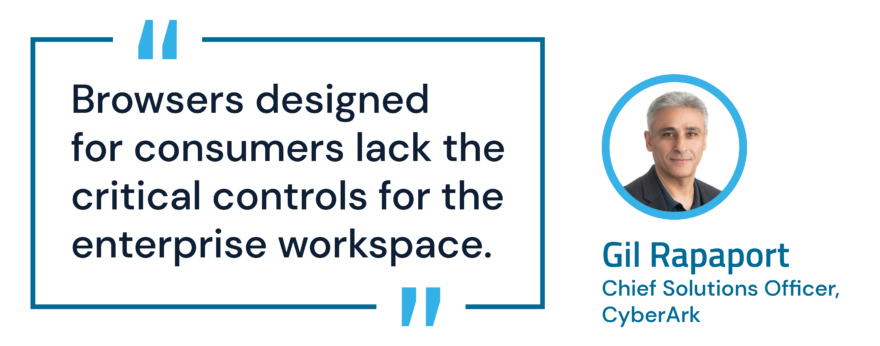
Now is the time.
It’s been over 30 years since the introduction of the first web browser. Since then, the browser has evolved into an application that allows us to stream entertainment, work and interact through social media. It’s the most widely used application among consumers … and now the enterprise.
Unfortunately, there’s little separation between work and personal life when you use a browser designed for consumer use. In short, it means any organization’s security is at risk – and there’s no lack of data breach headlines to make this painfully obvious.
In my travels over the years with CyberArk and as an entrepreneur, I’ve had numerous conversations with CISOs, CIOs and security practitioners about security risks and what this means for the browser. There’s consensus in the realization that consumer browsers like Google’s Chrome, Microsoft’s Edge and Apple’s Safari aren’t enough for the workplace.
In recent years, attackers have exploited vulnerabilities in consumer browsers by stealing cookies to breach organizations. In fact, our CyberArk Labs team has conducted research on cookie theft that resulted in hijacked sessions. In minutes, they can demonstrate how to take over sessions quickly. It’s a scary scenario, but we must ensure organizations are protected using an enterprise browser through cookieless sessions and a true passwordless solution.

So, here’s the problem: browsers designed for consumers lack critical controls for the enterprise workspace. They don’t consider the surge of workforce identities and the multitude of endpoints employees use to access company data. This shortcoming opens consumer-based browsers to vulnerabilities attackers can exploit to steal an organization’s critical data. It’s a significant gap for any organization, especially when workers use a regular browser to access corporate resources.
At CyberArk, we listened to our customers, and today, we’re excited to deliver an identity-focused enterprise browser that provides added protection to one of the most frequently used applications in any organization. An enterprise browser is the gateway to securing identities and your corporate data.
There are three key areas a secure identity-focused browser will address in any organization:
- Improved security
- Enhanced productivity
- Increased privacy
Improved Security Driven by SaaS
In the last decade, enterprises have rapidly shifted toward using SaaS-based applications for work fueled by on-premises applications that have transformed into SaaS models. This transformation of how we work, combined with the fast-paced growth in identities thanks to remote workforces, unmanaged Bring Your Own Device (BYOD) policies, new environments and attack methods, have all contributed to the need to improve how we protect an enterprise from all access points.
The shift toward SaaS was also fueled heavily by the pandemic’s onslaught. Now, with remote workers more reluctant to return to an office setting, the hybrid work model or even a fully remote office has become the wave of the future.
Accessing our enterprise resources through the browser drives the need for an added layer of security that sits within the security infrastructure. At CyberArk, we take a defense-in-depth, layered security approach to securing web sessions, least privilege on endpoints, passwordless and privileged access, for example. A secure browser brings the layers together at the highest level to secure our identities and serve as the gateway to our corporate data.
Enhanced Workforce Productivity
There’s a balance between security and worker productivity. How we protect the enterprise using a secure browser cannot come at the cost of worker productivity. An enterprise browser must offer the same seamless, familiar experience as their favorite browser, providing users access to their enterprise resources without affecting the user experience. It must be frictionless.
Workers will find that using a secure enterprise browser will be a better experience. Users can log into their enterprise resources from the enterprise browser without requiring reauthentication for every federated application and those that are password protected, accelerating the user’s workflow to a single click. The enterprise browser secures users without impacting productivity. It’s a win-win scenario.
Improved Flexibility for Security Compliance and Privacy
Compliance concerns are becoming greater and greater as new cybersecurity regulations require tighter restrictions on privacy. CISOs are also held responsible by their boards for ensuring their organizations comply with existing and new security regulations. Compliance and privacy teams continually work toward ensuring organizations adhere to the regulations that prescribe how corporate data is used and stored and that users and customers receive the privacy required for their data.
Consumer-based browsers store everything – from passwords to credit card data – in, say, Google Cloud. They also share data with third-party apps, expanding the attack surface. The enterprise browser shifts control back into the hands of security teams, providing organizations the flexibility to determine which data can reside in the cloud and which should remain on corporate premises. It offers built-in security to support compliance and help ensure privacy regulations are already in place. This capability alleviates concerns from compliance and privacy teams, knowing that critical enterprise data remains secure through flexible storage options and addresses privacy concerns before users access applications and data resources.
Secure Identities With an Enterprise Browser
As the industry continues to fend off new attacks and an evolving attack surface, our customers cannot be exposed to vulnerability gaps from unprotected browsers. In the current reality, the browser is an island among the IT admin’s security infrastructure with less consideration for security. This approach must change for organizations to implement an enterprise browser fully integrated within the security stack to help ensure identities don’t become compromised. However, we must balance security with worker productivity and offer a frictionless user experience.
It’s critical for your future, so now is the time.
Learn more about CyberArk Secure Browser and take a step toward securing your organization and all its identities.
Gil Rapaport is CyberArk’s Chief Solutions Officer.























